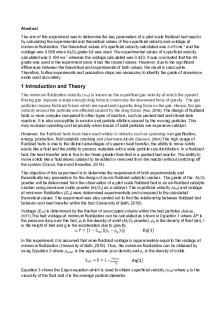Engineering Materials Lab Report 4 PDF

| Title | Engineering Materials Lab Report 4 |
|---|---|
| Author | Maira Albanez |
| Course | Engineering Materials |
| Institution | University of Massachusetts Lowell |
| Pages | 4 |
| File Size | 122.5 KB |
| File Type | |
| Total Downloads | 8 |
| Total Views | 141 |
Summary
Lab report....
Description
THINGS TO LOOK FOR:
What kind of testing machine was used? INSTRON Model 1332, capable of tension and compression. 3000 psi testing system. It is a Servohydraulic that uses oil.
What part of the testing machine moves during the test and what makes it move? Oil is put under pressure, 3000 psi. There is a controlled flow of oil into the actuator (cylinder) by the LVDT, making the machine frame move up.
What was the shape of the tensile specimen? Cylinder with narrow center and threaded ends.
What kind of fixtures held the sample? What kind of fixtures would be used if the specimen did not have threaded ends? Fixtures with threaded grip were used. If the ends were not threaded the appropriate grip would be a wedge grip, because it holds tighter the more the sample pulls on it.
How was the speed of testing controlled? The computer generates a ramp when the test starts, feedback of the errors is sent from the data being collected by the computer to the machine, which then controls how much oil is going into the LVDT, causing the machine to speed up or slow down depending on the chosen position control rate that was input on the computer. In this case, position control with rate of 0.25 in/min was used.
How was the elongation of the sample measured? Using an extensometer.
What is the function of the extensometer? The extensometer is attached to the sample in order to measure the elongation between the ends of the sample.
What data was taken? How was data recorded? The data was taken by the computer that generated a ramp indicating the stress and strain applied to the sample. Data was taken by recording stress and displacement.
Measuments: Diameter of the specimen before the test: d = 0.505 in Distance between grip faces: D = 2.575 in Diameter of specimen after the test: d = 0.300 in
2
RESULTS:
Material Property
Stress vs Strain
Proportional Limit
47 ksi
Modulus of Elasticity
30,000
Yield
53 ksi
Tensile Strength
74 ksi
Rupture Strength
53 ksi
Rupture Strength (Actual)
Comments Labeled as A on Graph 1 part 1 Labeled as ME on Graph 1 part 1 Labeled as y on Graph 1 part 1 Labeled as TS on Graph 1 part 2 Labeled as RS on Graph 1 part 2 Calculation on page 5
Modulus of Resilience
0.03995
Calculation on page 5
Modulus of Toughness
26.6
Calculation on page 5 Calculation on page 5
Percent Reduction of Area
CALCULATIONS: 3
Modulus of Elasticity ( E )=
σ 40 −10 =30,000 = ∈ 0.0015−0.0005
Vcylinder = πr²h = π (0.2525)² (2.575) = 0.516 in³
Rupture Strength actual=¿
1 1 Modulus of Resilience= ∈PL . σ PL= ( 0.0017 )( 47 )=0.03995 2 2
Modulus of Toughness= A1 + A2 + A3 + A 4 1. 2. 3. 4.
bh (0.002 )(53 ) =0.053 = 2 2 A 2=bh= ( 0.010 −0.002 ) (51 ) =0.408 b ( 0.39−0.025 ) π h π( )(74 −53) 2 2 =6.02 = A 3= 2 2 A 4 =bh=( 0.39−0.01 ) ( 53) =20.14 A 1=
()
Modulus of Toughness=26.6
Percent Reduction of Area=¿
4...
Similar Free PDFs

ENGINEERING MATERIALS LAB REPORT
- 1 Pages

Mechanical engineering lab report
- 18 Pages

Materials engineering lecture
- 6 Pages

Lab 4 - Lab testing report
- 5 Pages

Lab 1-4 - lab report
- 7 Pages

Jas Lab report #4 - lab
- 3 Pages

Phys lab 4 - Lab report
- 10 Pages

Lab 4 copy - Lab Report
- 5 Pages

Physics Lab 4 - lab report
- 5 Pages

Orgo Lab 4 - Lab Report 4
- 5 Pages

LAB 4 - Lab Report 4: Chem 221
- 9 Pages

Lab report 4 experiment 4
- 12 Pages
Popular Institutions
- Tinajero National High School - Annex
- Politeknik Caltex Riau
- Yokohama City University
- SGT University
- University of Al-Qadisiyah
- Divine Word College of Vigan
- Techniek College Rotterdam
- Universidade de Santiago
- Universiti Teknologi MARA Cawangan Johor Kampus Pasir Gudang
- Poltekkes Kemenkes Yogyakarta
- Baguio City National High School
- Colegio san marcos
- preparatoria uno
- Centro de Bachillerato Tecnológico Industrial y de Servicios No. 107
- Dalian Maritime University
- Quang Trung Secondary School
- Colegio Tecnológico en Informática
- Corporación Regional de Educación Superior
- Grupo CEDVA
- Dar Al Uloom University
- Centro de Estudios Preuniversitarios de la Universidad Nacional de Ingeniería
- 上智大学
- Aakash International School, Nuna Majara
- San Felipe Neri Catholic School
- Kang Chiao International School - New Taipei City
- Misamis Occidental National High School
- Institución Educativa Escuela Normal Juan Ladrilleros
- Kolehiyo ng Pantukan
- Batanes State College
- Instituto Continental
- Sekolah Menengah Kejuruan Kesehatan Kaltara (Tarakan)
- Colegio de La Inmaculada Concepcion - Cebu



